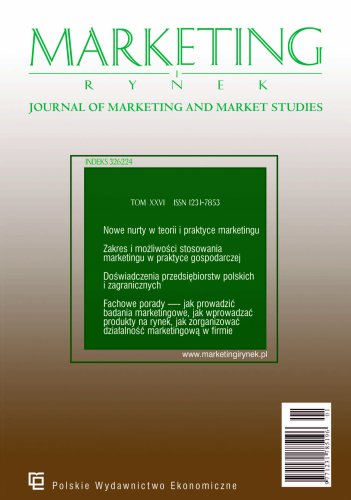About what is as popular in teaching management as it is controversial
The article concerns concepts widely known and used in teaching management, which either did not withstand scientific verification, or are highly controversial or misunderstood and misinterpreted. Three of them, relating to the key areas of management, namely communication, motivation and intercultural management, have been critically assessed. It covers the formula 7-38-55 by A. Mehrabian, the theory of the hierarchy of needs by A. Maslow and the concept of cultural dimensions by G. Hofstede. The article presents the background of the above mentioned concepts, their limitations, errors or inaccuracies. For each of the critically evaluated concepts, alternative concepts have been presented.
References
Bibliografia/References
Alderfer, C. (1972). Existence, Relatedness, and Growth. Free Press.
Amstrong, G., & Kotler, P. (2016). Marketing. Wydawnictwo Nieoczywiste.
Archer, D., & Akert, R. M. (1977). Words and everything else: verbal and nonverbal cues in social interpretation. Journal of Personality and Social Psychology, 35, 443–449. https://doi.org/10.1037/0022-3514.35.6.443
Bednarek, H. (2005). Sztuka budowania wizerunku. Wydawnictwo Naukowe Wyższej Szkoły Kupieckiej.
Betz, E. L. (1984). Two Tests of Maslow's Theory of Need Fulfillment. Journal of Vocational Bahavior, 24(2), 204–220. https://doi.org/10.1016/0001-8791(84)90007-1
Boski, P. (2010). Kulturowe ramy zachowań społecznych. Wydawnictwo Naukowe PWN.
Browayes, M-J., & Price, R. (2008). Understanding Cross-cultural Management. Prentice Hall.
Corning, P. A. (2000). Biological Adaptation in Human Societies: A „Basic Needs” Approach. Journal of Bioeconomics, 2(1), 41–86. https://doi.org/10.1023/A:1010027222840
DeVito, J. A. (2009). The essential elements of public speaking. Pearson Education.
Francesco, A. M., & Gold, B. A. (2005). International Organizational Behavior. Second Edition. Pearson Prentice Hall.
German, K. M. i in. (2011). Principles of public speaking. Allyn & Bacon.
Hofstede, G. (1985). The interaction between national and organizational value systems. Journal of Management Studies, 22, 347–357. https://doi.org/10.1111/j.1467-6486.1985.tb00001.x
Hofstede, G. (2001). Culture's consequences: Comparing values, behaviors, institutions and organizations across nations. Second Edition. Thousand Oaks, Sage.
Hofstede, G., Hofstede, G. J., & Minkov, M. (2011). Kultury i organizacje. Polskie Wydawnictwo Ekonomiczne.
House, R. J., Hanges, P. J., Javidan, M. J., Dorfman, P. W., & Gupta, V. (2004). Culture, Leadership, and Organizations. Sage Publications.
Krauss, R. M., Apple, W., Morency, N., Wenzel, C., & Winton, W. (1981). Verbal, vocal and visible factors in judgements of another's affect. Journal of Personality and Social Psychology, 40, 312–320. https://doi.org/10.1037/0022-3514.40.2.312
Lawrence, P. R., & Nohria, N. (2002). Driven: How Human Nature Shapes Our Choices. Jossey-Bass.
Lucas, S. E. (1989). The art of public speaking. McGraw-Hill.
Maslow, A. (1954). Motivation and personality. Harper & Row Publishers.
McShane, S. L., & Von Glinow, M. A. (2010). Organizational Behavior. 5th edition. McGraw-Hill.
Mehrabian, A. (1971). Silent Messages. Wadsworth Publishing Company, Inc. Belmont, California.
Mehrabian, A. (1997). Impressions created by given names. Names, 45, 19–33. https://doi.org/10.1179/nam.1997.45.1.19
Mehrabian, A. (2015). Theoretical foundation for emotion-based strategies in political campaigns. In A. Kostic, & D. Chadee (Eds.), The social psychology of nonverbal communication (pp. 198–219). Palgrave Macmillan. https://doi.org/10.1057/9781137345868_10
Mehrabian, A., & Ferris, S. R. (1967). Inference of attitudes from nonverbal communication in two channels. Journal of Consulting Psychology, 31, 248–452. https://doi.org/10.1037/h0024648
Mehrabian, A., & Wiener, M. (1967). Decoding of inconsistent communications. Journal of Personality and Social Psychology, 6, 109–114. https://doi.org/10.1037/h0024532
Mehrabian, A., & Wixen, W. J. (1986). Preferences for individual video games as a function of their emotional effects on players. Journal of Applied Social Psychology, 16, 3–15. https://doi.org/10.1111/j.1559-1816.1986.tb02274.x
Mikuła, B., & Pietruszka-Ortyl, A. (Red.). (2019). Zachowania organizacyjne. Zarys problematyki. Wydawnictwo Uniwersytetu Ekonomicznego w Krakowie.
Osborn, M., Osborn, S., & Osborn, R. (2009). Public speaking. Pearson Education.
Thomas, D. C., & Petersen, F. (2018). Cross-cultural management. Sage.
Valdez, P., & Mehrabian, A. (1994). Effects of color on emotions. Journal of Experimental Psychology: General, 123, 394–409. https://doi.org/10.1037/0096-3445.123.4.394
Wahba, M. A., & Bridwell, L. G. (1976). Maslow reconsidered: A review of research on the need hierarchy theory. Organizational Behavior and Human Performance, 15, 212–240. https://doi.org/10.1016/0030-5073(76)90038-6

